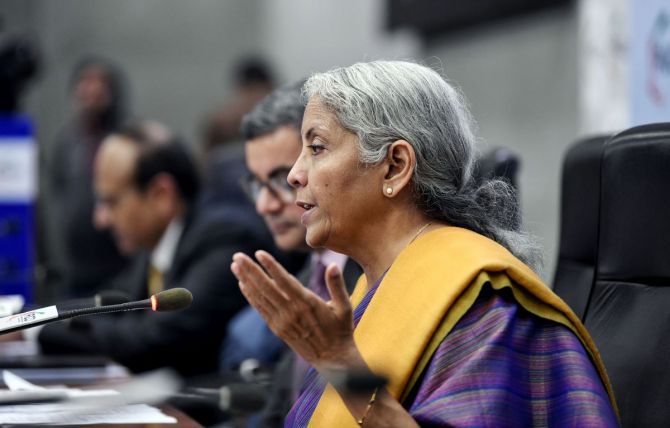Let's wait for the monetary policy on February 8 -- to see how it complements the fiscal commitments, points out Tamal Bandyopadhyay.

The two-act drama on fiscal-monetary dynamics is staged in February every year.
The first, the Union Budget, played on Wednesday and the second, the Reserve Bank of India's monetary policy, the last in the currency fiscal year, is a week away.
We could not have a better first act -- the first Budget in Amrit Kaal and fifth of Finance Minister Nirmala Sitharaman.
The Budget estimated the nominal GDP growth at 10.5 per cent in FY23, lower than what the Economic Survey, tabled a day ahead, projected.
Besides sticking to the 6.4 per cent estimated fiscal deficit of FY23, it has also charted out the fiscal glide path by pegging fiscal deficit at 5.9 per cent in FY24, paring it by 50 basis points.
One bps is a hundredth of a percentage point.
Going forward, the cut will be even sharper -- an average of at least 70 bps a year.
The finance minister reiterated her comment to bring down the fiscal deficit below 4.5 per cent by FY26.
It will be financed by government borrowing besides small savings and disinvestments to the tune of Rs 61,000 crore.
How much will the government borrow?
The gross market borrowings are estimated at Rs 15.4 trillion and net of redemption, the net borrowing Rs 11.8 trillion.
Yes, it is the highest ever government borrowing programme, but well in line with market expectations.
In FY20, the annual gross borrowing of the government was Rs 6.5 trillion which got more than doubled in Covid-hit FY21, Rs 13.7 trillion.
The next year, it came down to Rs 11.28 trillion but rose again to Rs 14.21 trillion in FY23. Till now, it has borrowed Rs 12.71 trillion.
Add to that the state borrowing of Rs 5.09 trillion. This makes the total borrowing so far Rs 17.80 trillion.
We need to wait and watch for the quantum of state borrowing in FY24.
Of course, two factors will have a bearing on the actual borrowing -- the realisation from the estimated Rs 61,00 crore disinvestment programme and the small savings collections which have been lower in the current fiscal year due to rising bank deposits.
Looking at the borrowing figure, the bond market heaved a big sigh of relief.
The yield on the 10-year bond which was 7.4 per cent on Tuesday, dropped to 7.28 per cent.
Even though the financial landscape has changed with the exit of easy liquidity, decadal high credit growth and banks fighting hard for deposits, the borrowing programme is unlikely to disrupt the market, particularly when the central banks globally are expected to dial down rate hikes.
However, new tax provision on certain insurance policies may dent the demand from insurance firms for government bonds.
Both insurance firms and mutual funds have been buying bonds in a big way in the current fiscal year.
There are other elements in the Budget which have a bearing on the banking sector.
The agriculture credit target is being raised by 11 per cent to Rs 20 trillion with focus on animal husbandry, dairy and fisheries.
The credit guarantee scheme for the MSMEs is being revamped through Rs 9,000 crore infusion in the corpus.
This will create additional collateral-free guaranteed credit of Rs 2 trillion and the cost of credit will come down by about 1 percentage point.
The KYC process will be simplified and, finally, a national financial information registry will be set up to serve as the central repository of financial and ancillary information.
The June 2018 monetary policy of the RBI had announced the establishment of a Public Credit Registry.
I guess the proposed registry will have the same architecture under a different name.
It is a centralised database for aggregating financial and non-financial information from several databases.
The idea behind it is to create records of everything that the regulators, lending institutions, credit bureaus, rating agencies and even the borrowers themselves want to know.
Finally, the Budget talks about public consultation for regulation-making.
The financial sector regulators are being requested to carry out a comprehensive review of existing regulations to simplify, ease and reduce cost of compliance.
It seems to be a leaf out of the think tank Organization for Economic Co-operation and Development book which advocates public consultation to make regulatory policy and governance more inclusive and strengthen the accountability of governments when developing, reviewing and enforcing regulations.
The banking sector should not have any complaints.
The 33 per cent rise in capex outlay should bolster credit growth while cuts in personal income tax can boost savings as well as retail loan growth.
It takes two to tango. Let's wait for the monetary policy on February 8 -- how it complements the fiscal commitments.
Tamal Bandyopadhyay, a consulting editor of Business Standard, is an author and senior adviser to Jana Small Finance Bank.
Feature Presentation: Ashish Narsale/Rediff.com











